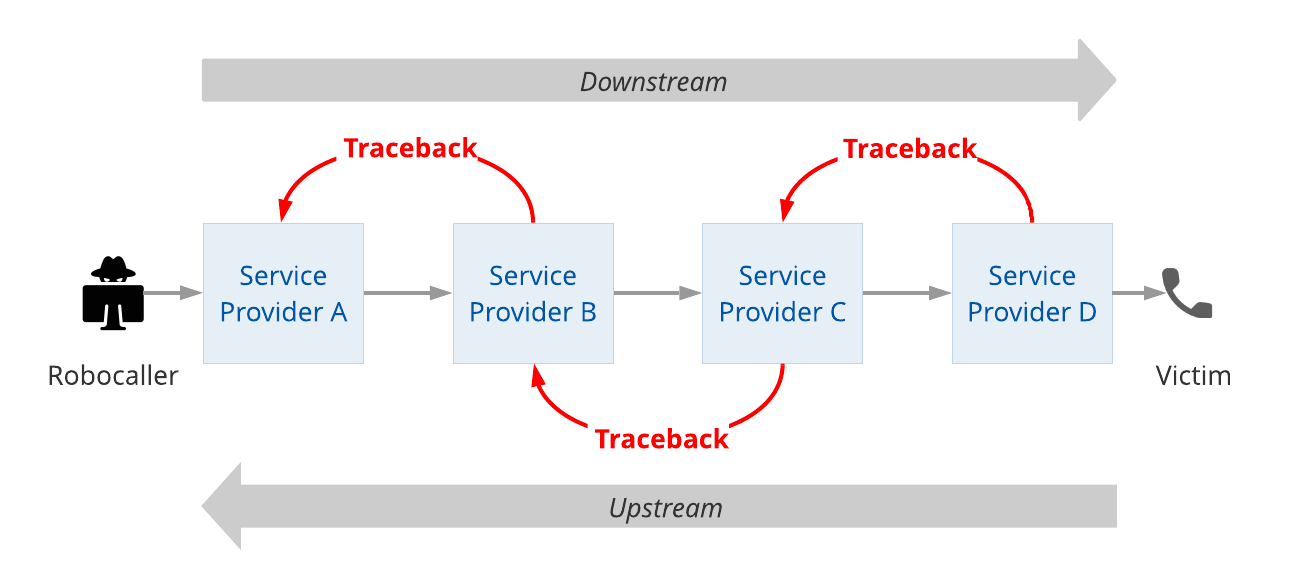ITG report—Combatting Illegal Robocalls
The Industry Traceback Group (ITG) just published a new report, Combatting Illegal Robocalls, with interesting statistics on scam robocalls in the U.S. and progress on eradicating them through traceback. Here are highlights of this report.
About the ITG
USTelecom — The Broadband Association created the ITG in 2015 to foster cooperation in combatting illegal robocalls. In 2020, the FCC designated the ITG as the Robocall Traceback Consortium, an official role established by the TRACED Act.
We described the traceback process in a blog post on robocall traceback in the U.S. The process starts from the robocall recipient and uses an online portal to organize a process where each voice service provider identifies the next upstream provider from which they received the robocalls.
Each provider adds information to the case


Report highlights
The report provides some interesting statistics.
Illegal robocalls continue to evolve
- In 2020, Americans fell for scam callers 270% more often than in 2019.
- 90% of scam calls from abroad now show up as U.S. numbers.
- 89% of seniors receive at least one robocall per week.
- 56% receive at least seven robocalls per week.
- The FCC estimates that the cost of wasted time and nuisance caused by scam robocalls exceeds $3 billion each year.
- Fraudulent robocall schemes cost Americans about $10 billion annually.
Traceback highlights in 2020
This traceback relies on timely compliance and participation from providers. Over time, the process has become more efficient and effective, as demonstrated by these ITG statistics from 2020:
- The ITG initiated more than 2,500 tracebacks representing hundreds of millions of robocalls.
- They conducted approximately 215 tracebacks per month.
- Up 115% from 2019 and 975% from 2018
- They received 75 subpoenas/civil investigative demands, which was up 275% from 2019.
- The ITG supported nearly a dozen enforcement actions targeting nearly 50 individuals and entities.
- The average time to complete a traceback was approximately four days, down 50% from 2019.
- The average time to complete an individual traceback segment (“hop”) ws now less than one day.
- Many providers regularly respond in less than 30 minutes.
See the full report Combatting Illegal Robocalls for further details.
Regulatory compliance with traceback
In the Fourth Report and Order on Advanced Methods to Target and Eliminate Unlawful Robocalls (CG Docket No. 17-59) released December 30, 2020, the FCC required voice service providers to participate in traceback. Here are important quotes from the order:
We adopt our proposal to require all voice service providers to respond to traceback requests from the Commission, civil and criminal law enforcement, and the Consortium...
Some commenters express concern that traceback requests may not go to the correct contact within the organization. We encourage voice service providers to publicly designate a point of contact for such requests...
We generally expect responses within a few hours, and certainly in less than 24 hours absent extenuating circumstances. Patterns of delayed response may lead to Commission enforcement.
TransNexus robocall mitigation solutions
We offer robocall mitigation solutions in our ClearIP and NexOSS software products. Contact us today to learn how we can help you prevent nuisance and scam robocalls from originating in or entering your network.
TransNexus has a comprehensive suite of robocall mitigation solutions to prevent the origination of unlawful robocalls.
Learn more about robocall mitigation